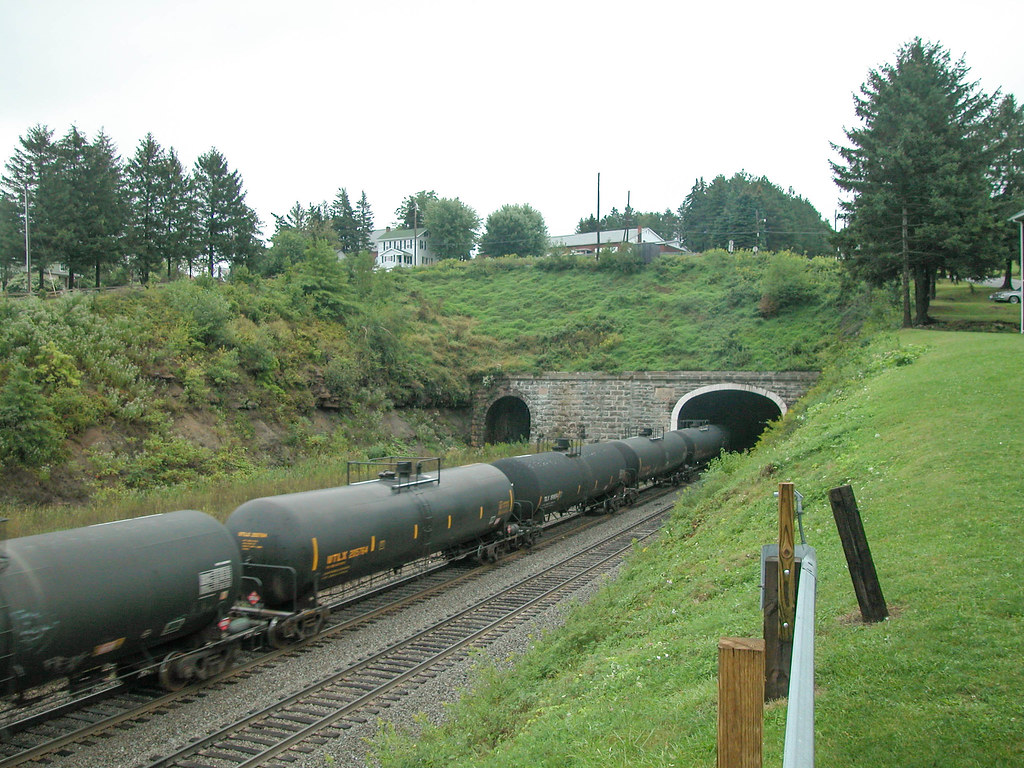
The Gallitzin Tunnels, located in Gallitzin, Pennsylvania, are a historic train observation spot featuring two railroad tunnels that were crucial for the Pennsylvania Railroad. Visitors can watch trains pass through the scenic Allegheny Mountains, offering a unique glimpse into the region's rich railroading history.
Photos
Sign in to upload photos
No Photos Yet
Be the first to share photos of this location!
Gallitzin Tunnels – Gallitzin, Pennsylvania, USA | Train Spotting Location
Trainspotting Experience
A typical visit offers close-up, track-level vantage points where trains burst from the twin active bores—Allegheny and New Portage—only seconds apart. The confined cut amplifies every horn blast and dynamic-brake whine, so expect ground-shaking acoustics as 12,000-ton freights grind upgrade at roughly 20–25 mph, then accelerate eastward toward Horseshoe Curve. Westbounds descend, dynamic brakes screaming, providing an entirely different soundtrack. Because the tracks are curved on both sides of the portals, consists seem to materialize suddenly, adding an element of surprise. Lighting in the cut can switch from deep shade to brilliant sun in moments, keeping photographers alert.
Landscape, Setting & Local Atmosphere
At nearly 2,200 feet above sea level, the site sits in a saddle between forested ridges. Mixed hardwoods—oak, maple, and hemlock—frame the right-of-way, while rocky outcrops reveal the sandstone strata pierced by the tunnels. Spring brings pastel wildflowers; autumn ignites the hillsides in red and gold. Humidity often forms wisps of fog that hug the portals at dawn, adding drama to first-light shots. Summers are generally mild, with mountain breezes tempering heat; winters can be harsh, delivering snow-dusted portals and exhaust plumes that linger in the frigid air. Despite proximity to the borough of Gallitzin, the location feels remote once the rumble of steel wheels fades, replaced by wind rustling through treetops.
Type & Frequency of Train Activity
Gallitzin sits on Norfolk Southern’s Pittsburgh Line, the railroad’s primary conduit between the Midwest and the East Coast. On an average weekday, railfans can expect 40–50 movements:
• Heavy mixed freights transporting coal, grain, and manifest traffic
• High-priority intermodal and autorack trains hustling at up to 35 mph once clear of the grade
• Two daily Amtrak Pennsylvanian passenger trains providing a brief splash of Phase III stripes amid the black NS diesels
Distributed power units are common on the longest freights, with mid-train or rear DPUs rumbling into the portal minutes after the leaders emerge. Heritage-painted units occasionally appear, adding bonus excitement.
Best Angles for Photos & What Railfans Enjoy Most
Photographers favor three classic positions:
- Eastern rim overlook: A short uphill footpath leads to an elevated perch above the east portals, perfect for broadside views of westbounds and head-on frames of trains exiting the mountain. Morning light side-illuminates locomotives; afternoons backlight exhaust for dramatic silhouettes.
- Cut level near the fence line: From a safe, publicly accessible spot, railfans can capture nose-level shots of engines exploding out of darkness. This angle highlights tunnel masonry, LED signal masts, and the train’s length disappearing into the S-curve.
- Western tree line: Late-day sun floods west portals, ideal for golden-hour compositions with the town’s church steeple peeking above the consist. Telephoto lenses compress the scene, emphasizing the grade.
Because trains often crawl upgrade, long-exposure night photography of light trails is possible without excessive blur. Wide-angle lenses emphasize the confined rock walls, while drones (flown in compliance with FAA rules) can reveal all three bore alignments in a single frame.
Historical or Cultural Relevance
Completed in 1854 by the Pennsylvania Railroad, the original Gallitzin Tunnel spearheaded the first rail route over the Alleghenies, replacing portions of the famed Allegheny Portage Railroad. The New Portage Tunnel followed in 1855, and the larger Allegheny Tunnel opened in 1904 to ease traffic congestion. Together, they symbolized the PRR’s engineering prowess and accelerated industrial growth for Pittsburgh and the eastern seaboard. Nearby exhibits commemorate local sons who worked the line, reinforcing the town’s identity as a railroad community.
What Makes This Spot Different
Few locations combine triple-track tunnel portals, constant heavy tonnage, mountain acoustics, and easy public access in one compact setting. Unlike open stretches such as Horseshoe Curve, Gallitzin funnels all traffic through a narrow rock cut, magnifying sound and delivering point-blank visual impact. The ability to observe both uphill struggle and downhill braking in the same hour, against a backdrop of 19th-century masonry, sets Gallitzin apart from typical flatland hotspots.
Seasonal Information
For observing trains at the Gallitzin Tunnels in Pennsylvania, spring and fall offer mild weather and scenic views with blooming flowers or colorful foliage. Summer provides longer daylight hours, while winter offers picturesque snowy landscapes. Check for special rail events and dress appropriately for the season.
External Links
Other Interesting Locations
Looking for more spots? Browse the complete list of train spotting locations.
Quick Information
Country
USA
Region / State / Province
Pennsylvania
City
Gallitzin
Spot Type
Tunnel
Best Times
Best hours to observe trains at Gallitzin Tunnels are during daylight, especially morning (7-9 AM) and evening (5-7 PM) on weekdays for peak train frequency.
Access & Amenities
Parking
Not available
Shelter
Not available
Restrooms
Not available
